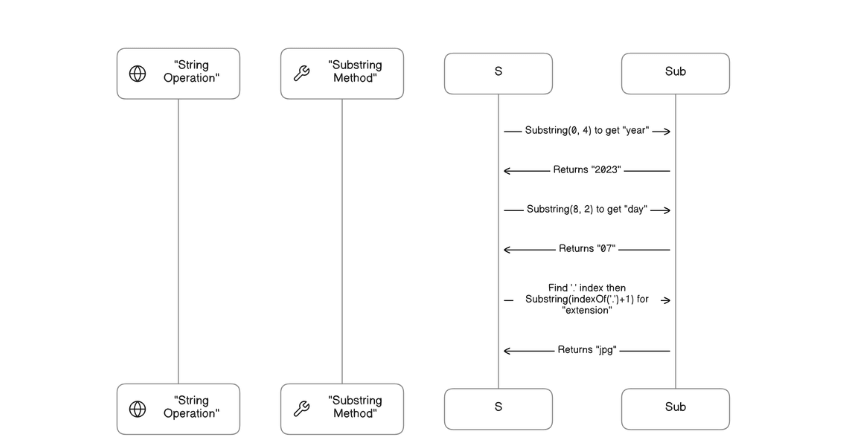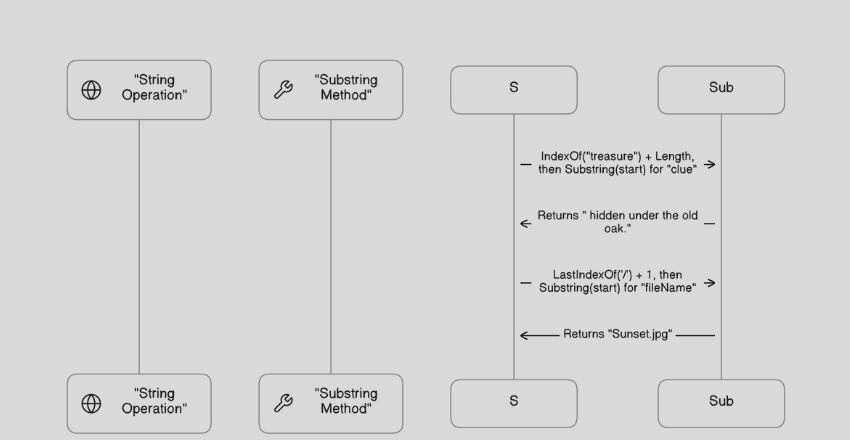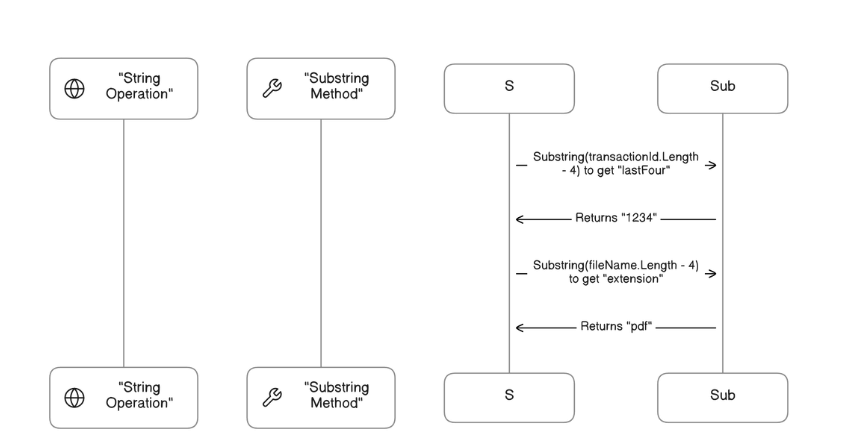Substring-in-C-Sharp provides a seamless way to manipulate strings, essential for data parsing and user input validation in software development.
Ever struggled with substrings in C#? Let me break it down for you.
There’s a common pitfall many face when dealing with substrings in C#. Let’s talk about it.
I’ve navigated through tricky substrings in C# for years. Here’s what works best.
What is a Substring in C#?
In C#, a substring is a part of a string. Think of it as a slice from a larger text. This concept is crucial for any form of text data manipulation, whether you’re pulling information from user inputs, parsing files, or just formatting text for display.
Overview
A substring helps you work with smaller pieces of a string. For example, if you have a string like “Hello, World!” and you only need the “Hello” part, a substring is your tool of choice. C# makes this easy with built-in methods.
Let’s break it down with an example:
string greeting = "Hello, World!";
string hello = greeting.Substring(0, 5);Here, greeting.Substring(0, 5) means “start at character 0 (H) and grab 5 characters”. The result is “Hello”. This simplicity is powerful. It lets you dive into strings, extract bits, and manipulate them as needed.
Substrings are everywhere in C#. You’ll use them for tasks like extracting usernames from email addresses, file extensions from paths, or just about any scenario where you need a piece of a string. With substrings, you’re dissecting strings, getting what you need, and leaving the rest. It’s a fundamental skill, a daily tool in your C# toolkit.
What Does Substring Do in C#?
In C#, Substring is a precision tool. It lets you pinpoint and extract exactly the parts of a string you need. This method is indispensable, from data extraction to input validation and more.
Purpose
The Substring method shines when you’re dealing with strings that contain a mix of information. Say you’ve got a string with user data, like “JohnDoe:1987”. You want to separate the name from the birth year.
Here’s how Substring makes that easy:
string userData = "JohnDoe:1987";
int separatorIndex = userData.IndexOf(':');
string name = userData.Substring(0, separatorIndex);
string year = userData.Substring(separatorIndex + 1);This code splits the string into “JohnDoe” and “1987”. It searches for the colon, then uses Substring to grab the name and year based on that position. Simple and effective.
Substring is also about safety and precision. It lets you work with strings in a way that avoids errors. If you try to extract a substring that doesn’t exist, you’ll get a clear error. This immediate feedback is great for debugging.
In short, Substring is a tool you’ll reach for often. It’s about getting to the heart of what you need from a string. Whether it’s pulling a filename from a path, a domain from a URL, or any piece of a larger text, Substring is how you do it.
How to Use Substring in C

Using Substring in C# is like having a Swiss Army knife for strings. It’s versatile. You can cut strings down to size, whether you need the beginning, middle, or end.
Let’s start with the basics. The Substring method comes in two flavors:
Substring(int startIndex)takes you from the start index to the string’s end.Substring(int startIndex, int length)gives you control over where to start and stop.
Starting Simple
Imagine you have a date string: “2023-04-07”. You want just the year. Here’s how:
string date = "2023-04-07";
string year = date.Substring(0, 4);You start at 0 and grab 4 characters. Result? “2023”. It’s straightforward.
Getting More Specific
Now, let’s say you need the day from the same date string. This is where you count a bit more:
string day = date.Substring(8, 2);Start at 8, take 2 characters, and you get “07”.
From Index to End
What if you have a string with a filename and extension, like “photo.jpg”, and you want just the extension?
string filename = "photo.jpg";
string extension = filename.Substring(filename.IndexOf('.') + 1);
You find the dot, then slice from the character right after it to the end. That’s your “jpg”.
Overloads and Edges
Remember, Substring will complain if you ask for more than it can give. Say, asking for 10 characters when there are only 5 left. It throws an exception. So, always check the length of your string against what you’re asking Substring to do.
I’ve found Substring indispensable. It’s precise and flexible. Whether you’re parsing logs, extracting data from inputs, or formatting strings for output, Substring is your go-to method. Keep its basics and boundaries in mind, and it will serve you well in a wide array of string manipulation tasks.
How to Get a Substring from a String?
Getting a substring from a string in C# is a basic yet essential skill. It’s all about selecting a specific part of a string. You might need the first name from a full name, a keyword from a sentence, or a file extension. That’s where Substring comes in handy.
Basic Extraction
Say you have a full name, “Jane Doe”, and you want just “Jane”. You’d do this:
string fullName = "Jane Doe";
string firstName = fullName.Substring(0, 4);
Here, 0 is where you start, and 4 is how many characters you take. It’s simple. The result is “Jane”.
Another Example
Consider a longer string: “Error 404: Not Found”. You want the error code, “404”. Here’s how:
string errorMessage = "Error 404: Not Found";
string errorCode = errorMessage.Substring(6, 3);Start at 6, grab 3 characters, and you’ve got “404”.
From Index to End
Sometimes, you want everything after a certain point. Take “user@example.com”. You want the domain “example.com”. Here’s the trick:
string email = "user@example.com";
string domain = email.Substring(email.IndexOf('@') + 1);Find the @, then slice from the next character to the end. That’s your domain.
Tip from Experience
Here’s a tip: Always check your string’s length. Make sure your start index and length don’t go out of bounds. C# will throw an exception if they do. So, a quick check can save you debugging time later.
Substring is a tool you’ll use often. Whether you’re cleaning data, parsing inputs, or formatting text, knowing how to slice strings effectively is key. With practice, it becomes second nature.
How to Get a Substring of the First n Characters from a String?
Grabbing the first ‘n’ characters of a string is a common task. It’s like skimming the top off your morning coffee. You’re just taking what you need.
Quick Start
Imagine you’ve got a string: “OpenAI”. You want the first 4 characters. Here’s how:
string company = "OpenAI";
string slice = company.Substring(0, 4);You start at 0. Grab 4 characters. You end up with “Open”. It’s that simple.
Why Do This?
Let’s say you’re working with dates in the format “YYYYMMDD”. You need just the year. Apply what you’ve learned:
string date = "20240407";
string year = date.Substring(0, 4);You’ve got “2024”. The first 4 characters represent the year.
Real-World Use
I’ve used this countless times. Whether it’s logging tags, prefixes in codes, or just formatting outputs. It’s about getting to the point. Fast.
A Tip
Always know the length of your string. Asking for more characters than the string has will throw an exception. A simple length check can prevent this.
Getting the first ‘n’ characters is a fundamental skill in C#. It’s quick, useful, and efficient. Whether you’re parsing data or formatting strings, it’s a technique you’ll use over and over. Remember, in coding, sometimes less is more.
How to Get a Substring with a Start and End Index?
Getting a substring with a start and end index is about precision. You pinpoint exactly what you need. This technique is like using a scalpel in surgery—sharp and accurate.
Precision Cutting
Suppose you have a string: “Hello, World!”. You want “World”. Here’s how you do it:
string greeting = "Hello, World!";
int start = 7; // Start at 'W'
int end = 12; // End at 'd'
string world = greeting.Substring(start, end - start);You calculate the length by subtracting the start from the end index. This gives you “World”.
Why It Matters
This method shines when dealing with structured strings. Think of a scenario with a formatted message: “Name: John, Age: 30”. You want to extract “John”.
string info = "Name: John, Age: 30";
int startName = info.IndexOf("Name: ") + "Name: ".Length;
int endName = info.IndexOf(", Age");
string name = info.Substring(startName, endName - startName);This extracts “John” by calculating start and end positions.
From My Experience
I’ve seen countless data parsing tasks. Knowing how to precisely extract information is crucial. Whether it’s log messages, CSV fields, or formatted strings, this method is indispensable.
Pro Tip
Always verify your indices. Ensure they’re within the string’s bounds. An ArgumentOutOfRangeException is the last thing you want. A simple check can save a lot of headaches.
Mastering substring extraction with start and end indices is a fundamental skill in C#. It’s about getting exactly what you need, nothing more, nothing less. It’s precise, it’s efficient, and it’s something you’ll use again and again.
How to Get a Substring from Index to End?

Extracting from an index to the end of a string is like cutting a piece from a log. You start at one point and take everything from there onwards. It’s a handy technique in C#.
Getting to the End
Say you have a sentence: “Find the treasure hidden under the old oak.” You want everything after “treasure”. Here’s how:
string message = "Find the treasure hidden under the old oak.";
int start = message.IndexOf("treasure") + "treasure".Length;
string clue = message.Substring(start);
This snips out ” hidden under the old oak.”. You start right after “treasure” and grab all that follows.
Practical Use
This method shines when you’re dealing with strings where the end part is what you’re after. Consider a path: “C:/Users/Photos/Sunset.jpg”. You want just the filename.
string fullPath = "C:/Users/Photos/Sunset.jpg";
string fileName = fullPath.Substring(fullPath.LastIndexOf('/') + 1);You locate the last ‘/’, move one step beyond, and slice to the end. You get “Sunset.jpg”.
From My Experience
Over the years, this technique has been invaluable. Whether parsing file paths, extracting comments from code, or processing command-line arguments, it’s about isolating the relevant part of a string.
Pro Tip
Watch your index. If it’s off, you might end up with an unexpected slice of the string or, worse, an error. Always ensure your starting point is within the string’s bounds.
Cutting a string from a certain point to its end is a fundamental skill. It’s like focusing on the horizon. You ignore what’s behind and concentrate on what lies ahead. In C#, this approach simplifies handling dynamic content, making your code cleaner and more efficient.
How to Get a Substring After a Character?
Getting a substring after a character is like finding a needle in a haystack. You know it’s there; you just need to know where to look. This technique is key for parsing strings, especially when dealing with delimiters.
Pinpointing the Character
Imagine a sentence: “Key:Value”. You want everything after “Key:”. Here’s what you do:
string pair = "Key:Value";
string value = pair.Substring(pair.IndexOf(':') + 1);This cuts out “Value”. You find ‘:’, then slice right after it.
Why It’s Handy
This method is perfect when working with key-value pairs, URLs, or any string with a clear delimiter. Say you have “name=John”. You want “John”.
string data = "name=John";
string name = data.Substring(data.IndexOf('=') + 1);You locate ‘=’, then grab the rest. It’s straightforward.
Extracting substrings this way has been a staple. Whether it’s parsing query parameters from a URL or extracting a file extension, it’s about getting to what’s important.
Pro Tip
Always check if the character exists before slicing. If IndexOf returns -1, the character isn’t there. Trying to substring then can cause errors.
Extracting after a character is a fundamental skill in C#. It’s like zooming in on the part of the string that matters. With practice, it becomes a quick, reliable way to parse and process text.
How to Get a Substring Before a Character?
Getting a substring before a character is like stopping a video right before the climax. You go just up to the point you need. It’s crucial for dissecting strings, especially when you’re dealing with data formatted around specific delimiters.
Finding the Right Spot
Let’s say you have an email address: “user@example.com”. You want the user part, nothing more. Here’s the strategy:
string email = "user@example.com";
string user = email.Substring(0, email.IndexOf('@'));
This gives you “user”. You find the ‘@’ and cut everything before it.
Example
This technique shines in numerous scenarios. Imagine you have a filepath: “C:/Documents/Report.pdf”. You’re interested in the “Report” part only.
string filepath = "C:/Documents/Report.pdf";
string filename = filepath.Substring(filepath.LastIndexOf('/') + 1,
filepath.IndexOf('.') - filepath.LastIndexOf('/') - 1);
This snags “Report”. You locate the slashes and the dot, then extract what’s in between.
Leveraging Experience
This method has proven invaluable. Whether it’s extracting a username from an email or a file name from a path, it’s about isolating the essential part.
A Word of Caution
Be wary of the character not being present. If IndexOf returns -1, the character isn’t in the string. Attempting to use this as a start index will throw an error. Always verify the presence of the delimiter.
Cutting a string before a specific character is a basic yet powerful operation in C#. It’s like drawing a line in the sand, marking where the relevant information starts and stops.
How to Get a Substring Between Two Strings?
Extracting a substring between two strings is like finding treasure in a maze. You navigate through the text to find the hidden gem. This technique is essential for handling complex string structures.
Navigating the Maze
Imagine a sentence: “Start here and end there.” You want to capture what’s between “Start” and “end”.
Here’s the map:
string sentence = "Start here and end there.";
int start = sentence.IndexOf("Start") + "Start".Length;
int end = sentence.IndexOf("end");
string treasure = sentence.Substring(start, end - start).Trim();
This gives you “here and”. You mark the start and end, then chart the path between.
Example
This method is a lifesaver in scenarios like parsing HTML tags or extracting values from a string with a known format. Consider a string: “name=John; age=30; city=New York;”. You want “John”.
string data = "name=John; age=30; city=New York;";
int nameStart = data.IndexOf("name=") + "name=".Length;
int nameEnd = data.IndexOf(";", nameStart);
string name = data.Substring(nameStart, nameEnd - nameStart);You’ve isolated “John”. You pinpoint the start and end, then extract the value.
I’ve used this approach in data extraction, configuration parsing, and more. It’s about precision and knowing your start and end points.
Cautionary Note
Ensure both markers exist in the string to avoid errors. Check their indexes aren’t -1 before proceeding. An oversight here can derail your extraction.
Securing a substring between two strings is like precision surgery. It requires a steady hand and a clear eye. With this technique, you can dissect strings, revealing the information needed.
How Do I Get the Last 4 Characters of a String in C#?

Getting the last 4 characters of a string in C# is like looking at the end of a book for the twist. It’s often needed for codes, IDs, or file extensions.
Straight to the End
If you have “TransactionID1234”, and you need “1234”, here’s how:
string transactionId = "TransactionID1234";
string lastFour = transactionId.Substring(transactionId.Length - 4);This slices out “1234”. You calculate the start point from the string’s length minus 4.
Why It Matters
This technique is useful for files like “report.pdf”. To get “pdf”:
string fileName = "report.pdf";
string extension = fileName.Substring(fileName.Length - 3);You grab the last 3 characters for the file extension.
Always ensure the string is long enough. Trying to subtract more characters than the string has will cause an error.
Extracting the last few characters is common in C# work. It’s simple but vital, especially when dealing with specific formats or data types.
Handling Null or Empty Strings
Handling null or empty strings is crucial. It’s like checking the weather before a hike. You want to be prepared.
Why Check?
If you try substring operations on null or empty strings, you’ll hit errors. It’s like trying to cut a cake that isn’t there.
The Check
For a string “text”, here’s how you ensure it’s safe to work with:
string text = "example";
if (!String.IsNullOrEmpty(text))
{
// Safe to perform operations
}
This is your basic check. It’s like looking outside to see if it’s raining.
Going Deeper
Sometimes, strings look full but are just air. They’re white spaces. Here’s the upgrade:
if (!String.IsNullOrWhiteSpace(text))
{
// Even safer, ignores just spaces
}
This is checking the weather and making sure it’s not just cloudy but actually clear.
Before extracting a substring, always use these checks. It’s like putting on your safety gear before climbing.
Null and empty checks are your first step in string manipulation. They’re your safety net.
Performance Considerations
Performance matters, like a well-oiled machine. Especially with substrings in loops, things can slow down. Here’s how to keep it speedy.
Loop Smart
When you’re looping through strings, each Substring call creates a new string. Imagine doing this thousands of times. It adds up.
Use StringBuilder
If you’re building strings in a loop, StringBuilder is your friend. It’s designed for this, reducing the workload.
StringBuilder sb = new StringBuilder();
for(int i = 0; i < 1000; i++)
{
sb.Append(i.ToString());
}
This is more efficient than concatenating strings in a loop.
Substring Less
Sometimes, you don’t need a substring. If you’re checking the start of a string, StartsWith does the job without slicing.
if (text.StartsWith("Hello"))
{
// Do something
}This avoids creating a new string, saving time.
Optimizing substring use is about being smart with your tools. In loops, think StringBuilder. And sometimes, skip the Substring altogether.
Advanced Substring Techniques
When Substring doesn’t cut it, Regex enters. It’s like using a smart saw for intricate patterns in woodworking.
Regex Power
Regex tackles complex patterns. Say you have strings with dates and you need to extract them. They’re scattered in text like “Event on 2023-04-07”. Regex finds these patterns.
Example
Here’s how you use Regex to grab dates:
using System.Text.RegularExpressions;
string text = "Event on 2023-04-07";
Regex datePattern = new Regex(@"\d{4}-\d{2}-\d{2}");
Match match = datePattern.Match(text);
if (match.Success)
{
string date = match.Value;
// date is "2023-04-07"
}This hunts down the “YYYY-MM-DD” pattern. When it finds one, you’ve got your date.
Why Regex?
Regex shines with irregular patterns. You might have “Date: 2024-04-07” or “2024/04/07 Event”. With Regex, you catch them all. It’s flexible.
Be Cautious
Regex is powerful but complex. It’s easy to make a mistake. Always test your patterns. And remember, Regex can be slower than Substring. Use it when necessary, not always.
Regex is your advanced tool for when Substring isn’t enough. It handles complexity with ease, giving you the precision for detailed string operations.
C# Substring Examples
Grabbing the first 3 characters of a string is like taking the first slice of pizza. It’s simple and often what you want first.
Example: First 3 Characters
Say you’ve got a string: “Apple”. You want “App”.
string fruit = "Apple";
string slice = fruit.Substring(0, 3);Here, slice equals “App”. You start at 0 and take 3 characters. It’s straightforward.
Why Do This?
It’s useful everywhere. From file extensions to language codes, starting segments often hold key info.
Example
Imagine filenames like “img001.jpg”. You want the “img” part.
string filename = "img001.jpg";
string prefix = filename.Substring(0, 3);prefix will be “img”. It identifies the file type.
Extracting starting segments has been a daily task. It’s quick, effective, and reliable.
The first 3 characters often tell you a lot. Whether it’s a code, type, or status, Substring gets you that critical start.
How to Check if a String Contains a Substring in C
Checking if a string contains a substring is like looking for a specific tool in your toolbox. You need to know if it’s there before you can use it.
Simple Check
To see if “apple” is part of “pineapple”:
string fullText = "pineapple";
bool containsApple = fullText.Contains("apple");If containsApple is true, you’ve found your tool.
Why This Matters
This check is essential. From filtering data to validating inputs, knowing if a piece exists guides your next step.
Example
Say you’re searching user comments for “error”:
string comment = "There was an error processing your request.";
bool hasError = comment.Contains("error");hasError tells you if action is needed.
Using .Contains has been a staple for quickly assessing string content. It’s efficient and straightforward.
Checking for substrings is a fundamental skill. It’s about quickly spotting what you need in a sea of data. With .Contains, you’re well-equipped to sift through text, making your code smarter and more responsive.
How to Split a String in C
Splitting a string in C# is like cutting a cake into slices. Each piece is something you can work with individually.
Splitting Basics
If you have a list like “apple,banana,cherry”, and you want each fruit separately, use Split:
string fruits = "apple,banana,cherry";
string[] fruitArray = fruits.Split(',');Now, fruitArray holds “apple”, “banana”, and “cherry” as separate elements.
Why Split?
It’s crucial for parsing data. CSV files or query parameters in URLs are common examples where you’ll use this.
Example
Imagine a CSV line: “John,Doe,30”. You need to process each value:
string csvLine = "John,Doe,30";
string[] values = csvLine.Split(',');values now contains “John”, “Doe”, and “30”.
I’ve split strings in countless scenarios. It’s effective for breaking down information and making it manageable.
The Split method turns a long string into accessible parts. Whether for data processing or input parsing, it’s a technique you’ll find indispensable. It’s about making the complex simple.
Removing a Substring from a String in C
Removing a substring from a string in C# is like erasing a mistake on paper. It cleans up your text.
How to Remove
If you have “Hello, World!” and want to remove “World”, here’s what you do:
string greeting = "Hello, World!";
string cleanGreeting = greeting.Replace("World", "");Now, cleanGreeting is “Hello, !”. “World” is gone.
Why Remove?
It’s useful for cleaning data, fixing errors, or prepping strings for further processing.
Example with Data
Imagine you’ve got “user@example.com” and need to hide the domain:
string email = "user@example.com";
string anonymizedEmail = email.Replace("@example.com", "");anonymizedEmail is now just “user”.
From Experience
Removing substrings has streamlined data, sanitized inputs, and tailored outputs. It’s a quick fix for many issues.
Using .Replace to remove substrings is straightforward and powerful. Whether erasing, cleaning, or anonymizing, it gets the job done.
C# Substring Alternatives
C# gives you a toolbox for string work, not just a single tool. Beyond Substring, there are methods like Remove, Replace, and regex. Each has its own specialty.
Remove for Precision Cuts
Remove is perfect when you know exactly where to cut:
string text = "Hello, World!";
text = text.Remove(0, 7); // Cuts "Hello, "Now, text is “World!”. It’s like using a scalpel.
Replace for Swapping
Need to change text or ditch unwanted parts? Use Replace:
string message = "I love coding in C++!";
message = message.Replace("C++", "C#");Message becomes “I love coding in C#!”. It’s swapping stickers.
Regex for The Complex
When the task gets tricky, regex is your hero:
string info = "Email: someone@example.com";
var email = Regex.Match(info,
@"\b[A-Za-z0-9._%+-]+@[A-Za-z0-9.-]+\.[A-Z|a-z]{2,}\b").Value;email finds “someone@example.com”. Regex is like a detective finding clues.
Substring is just the beginning. Remove, Replace, and regex expand your capabilities. They let you handle almost any string challenge.
Comparison with Similar Methods
How Substring compares to similar string manipulation methods in C#, such as span slicing, String.Split, or Regex, in terms of performance, usability, and scenarios.
Comparing Substring with similar methods in C# reveals distinct advantages and use cases for each.
Substring vs. Span Slicing
Substring is straightforward. You grab part of a string:
string example = "Hello, World!";
string world = example.Substring(7);Span<T> slicing, introduced in C# 7.2, offers a low-allocation way to work with slices of arrays, strings, or spans:
ReadOnlySpan<char> exampleSpan = example.AsSpan();
ReadOnlySpan<char> worldSpan = exampleSpan.Slice(7);Span slicing is more memory-efficient, especially in tight loops or high-performance scenarios, as it doesn’t create a new string.
Substring vs. String.Split
Substring is for extracting a specific part. String.Split breaks a string into an array based on a delimiter:
string[] parts = "one,two,three".Split(',');Use Split when you need to parse a string into multiple elements. Substring is better for a single, precise extraction.
Substring vs. Regex
Substring is simple and direct. Regex (regular expressions) handles complex patterns:
string input = "Name: John Doe, Age: 30";
string name = Regex.Match(input, @"Name: (.*?),").Groups[1].Value;Regex is powerful for pattern matching and extraction but can be overkill for simple needs. It’s also slower than Substring due to its complexity.
Substring is easy and quick for straightforward extractions. Span slicing is ideal for performance-critical applications. Split excels at dividing a string into parts.
Regex is unmatched for complex patterns. Choosing the right tool depends on your specific needs, balancing simplicity, performance, and flexibility.
Integration with Other .NET Features
How Substring integrates with other .NET features or libraries, like LINQ or async programming models, might reveal new possibilities for developers.
Integrating Substring with other .NET features opens new doors. Let’s dive into how it works with LINQ and async models.
Substring with LINQ
LINQ and Substring together can filter or transform collections elegantly. Imagine you have a list of codes and only want those starting with “AB”:
var codes = new List<string> { "AB123", "CD456", "AB789" };
var abCodes = codes.Where(code => code.Substring(0, 2) == "AB");Here, Substring helps LINQ pinpoint the right elements. It’s smooth and efficient.
Substring in Async Scenarios
Using Substring in async tasks is straightforward. Say you’re fetching a URL in the background and want the domain part:
public async Task<string> GetDomainAsync(string url)
{
// Simulate an async fetch
await Task.Delay(100); // Just for demonstration
int startIndex = url.IndexOf("://") + 3;
int endIndex = url.IndexOf("/", startIndex);
return url.Substring(startIndex, endIndex - startIndex);
}This method showcases how Substring fits into async operations, processing data once it’s available.
Substring plays well with LINQ, making data processing cleaner. In async models, it seamlessly integrates, handling data post-fetch. These integrations showcase .NET’s flexibility, allowing Substring to be a part of complex workflows.
Security Considerations
Security considerations when using Substring for processing user input or data manipulation could address concerns related to injection attacks or data integrity.
When using Substring for user inputs or data manipulation, security is key. Let’s touch on how to stay safe.
Guarding Against Injection
Imagine you’re slicing user inputs that go into a database query. If not handled carefully, you might open up for injection attacks. Always validate and sanitize inputs first:
string userInput = GetUserInput(); // This could be dangerous
if (!string.IsNullOrEmpty(userInput))
{
// Sanitize the input here
userInput = userInput.Substring(0, Math.Min(10, userInput.Length)); // Limit length
// Further sanitization and validation before use
}
This approach limits the input size, reducing risk.
Ensuring Data Integrity
When processing data, especially from external sources, using Substring without checks can lead to errors or manipulated data. Always verify the integrity first:
string data = GetExternalData();
if (!string.IsNullOrWhiteSpace(data) && data.Length > expectedLength)
{
string processedData = data.Substring(0, expectedLength);
// Now, processedData is safer to use
}
Here, checking length ensures you’re not working with tampered data.
Security with Substring boils down to validation and cautious processing. I’ve seen overlooked inputs cause chaos. Always sanitize user inputs and validate data before slicing. This practice guards against injection and preserves data integrity, keeping your applications secure.
Advanced Use Cases
Examples of advanced use cases, such as parsing complex data formats (e.g., JSON or XML strings) using Substring combined with other C# features.
Diving into advanced use cases, Substring combines well with C#’s features to tackle complex data, like JSON or XML.
Parsing JSON Strings
Imagine a simple JSON snippet: {"name":"John","age":30}. You need just the name value without a JSON parser:
string json = "{\"name\":\"John\",\"age\":30}";
int nameStart = json.IndexOf("\"name\":") + 7; // Start of "John"
int nameEnd = json.IndexOf("\"", nameStart); // End of "John"
string name = json.Substring(nameStart, nameEnd - nameStart).Trim(new char[]
{ '\"' });Here, Substring extracts “John”. It’s manual but effective for light tasks.
Working with XML
Given XML: <user><name>John</name><age>30</age></user>, and you want the age:
string xml = "<user><name>John</name><age>30</age></user>";
int ageStart = xml.IndexOf("<age>") + 5; // Start of "30"
int ageEnd = xml.IndexOf("</age>", ageStart); // End of "30"
string age = xml.Substring(ageStart, ageEnd - ageStart);Substring pulls out “30”. For small snippets, this method is quick.
While Substring is powerful, for full-fledged JSON or XML handling, consider libraries like Json.NET or System.Xml. They’re robust and handle complexities well.
Substring is versatile. Combined with C#’s features, it parses even complex formats. But remember, for heavy parsing, lean on dedicated libraries. I value Substring for quick tasks and libraries for the heavy lifting.
Examples of Common Mistakes
Common pitfalls and how to avoid them could provide practical value.
Common mistakes can trip up anyone, from beginners to seasoned pros. Let’s tackle a few related to Substring and how to dodge them.
Mistake 1: Ignoring String Length
Trying to grab more characters than available is a classic error.
string text = "Hello";
// Oops! This will throw an exception.
string oops = text.Substring(0, 10);Fix: Check the string’s length first.
string safeSubstring = text.Length > 10 ? text.Substring(0, 10) : text;Mistake 2: Negative Start Index
Using a negative start index is another common slip-up.
int startIndex = -1;
// This will cause an error.
string result = text.Substring(startIndex, 2);Fix: Ensure your index is always positive or zero.
int safeIndex = Math.Max(0, startIndex);
string result = text.Substring(safeIndex, 2);Mistake 3: Not Handling Null Strings
Calling Substring on a null string? That’s asking for trouble.
string nullText = null;
// This will throw a NullReferenceException.
string sub = nullText.Substring(0, 2);Fix: Always check for null or use null-conditional operators.
string sub = nullText?.Substring(0, 2);These mistakes are easy to make but also easy to fix. I’ve learned the importance of checking and double-checking string operations. Substring is a powerful tool, but it demands careful handling. With these tips, you’ll avoid common pitfalls and keep your code running smoothly.
Performance Best Practices
Optimizing substring operations, especially in tight loops or memory-sensitive applications, to address performance concerns.
Optimizing Substring operations is key in high-performance or memory-sensitive situations. Let’s break down how to keep things running smoothly.
Avoiding Excessive Substring Use in Loops
Using Substring inside tight loops can slow you down. Each call creates a new string, which can pile up.
Example: Looping to process parts of a string.
for (int i = 0; i < 1000; i++)
{
string part = original.Substring(i, 2); // Heavy on memory
}
Fix: Consider alternatives like character arrays or spans to minimize allocations.
Span<char> span = original.AsSpan();
for (int i = 0; i < 1000; i++)
{
ReadOnlySpan<char> part = span.Slice(i, 2); // Lighter on memory
}
Pre-Checking String Length
Long operations on strings might mean repeatedly checking their length. Doing this inside a loop is inefficient.
Example: Checking length in each iteration.
for (int i = 0; i < text.Length; i++)
{
if (text.Substring(i, 1) == "a") { /* ... */ }
}Fix: Cache the length outside the loop to avoid recalculating.
int length = text.Length;
for (int i = 0; i < length; i++)
{
if (text.Substring(i, 1) == "a") { /* ... */ }
}Choosing the Right Data Structure
In scenarios where strings are heavily manipulated, StringBuilder can be more efficient than repeatedly using Substring.
Example: Concatenating strings in a loop.
string result = "";
for (int i = 0; i < 100; i++)
{
result += text.Substring(i, 2); // Inefficient
}Fix: Use StringBuilder for concatenation.
StringBuilder sb = new StringBuilder();
for (int i = 0; i < 100; i++)
{
sb.Append(text, i, 2); // More efficient
}
string result = sb.ToString();Optimizing Substring usage is about avoiding unnecessary work and choosing the right tool for the job. I’ve seen these small changes make big impacts in performance-critical applications.
FAQ

Can I use Substring-in-C-Sharp on different operating systems?
Answer: Substring-in-C-Sharp works across all platforms. Whether you’re on Windows, Linux, or macOS, as long as you have a C# environment set up, you can use Substring without any issues.
Does Substring-in-C-Sharp behave the same on all platforms?
Answer: Substring-in-C-Sharp’s behavior is consistent across all platforms. The .NET framework ensures that string manipulation functions like Substring perform identically, regardless of the operating system.
Are there any performance differences in using Substring-in-C-Sharp on various platforms?
Answer: No, there are no significant performance differences when using Substring-in-C-Sharp across different platforms. Performance largely depends on the specifics of your project and the efficiency of your code, not the OS.
Can Substring-in-C-Sharp handle strings with non-English characters?
Answer: Substring-in-C-Sharp can handle strings with non-English characters. C# uses Unicode, so it supports a wide range of languages and characters in string operations.
Is there a limit to the size of the string Substring-in-C-Sharp can process?
Answer: Technically, there’s no set limit to the size of the string Substring-in-C-Sharp can process, but performance may vary with extremely large strings. It’s more about the capabilities of the machine and the efficiency of the code.
How does Substring-in-C-Sharp deal with indexes outside the string length?
Answer: If you try to use an index outside the string length with Substring-in-C-Sharp, you’ll encounter an ArgumentOutOfRangeException. Always ensure your indexes are within the bounds of the string.
Can I use Substring-in-C-Sharp to manipulate strings in real-time applications?
Answer: You can use Substring-in-C-Sharp for real-time string manipulations, such as in chat applications or live data processing. Its performance is generally suitable for real-time scenarios.
Do I need to import any specific libraries to use Substring-in-C-Sharp?
Answer: No additional libraries are needed to use Substring-in-C-Sharp. It’s a method available directly within the System.String class in the .NET framework.
How does Substring-in-C-Sharp handle null strings?
Answer: Attempting to use Substring-in-C-Sharp on a null string will result in a NullReferenceException. Always check if your string is null before applying substring operations.
What’s the most efficient way to use Substring-in-C-Sharp in high-performance loops?
Answer: For high-performance loops, minimize Substring-in-C-Sharp usage by caching string lengths and avoiding repeated substring calls. Consider using Span<T> or Memory<T> for slicing if targeting .NET Core or later.
FAQ 11: Can Substring-in-C-Sharp be optimized for memory usage in large-scale applications?
Answer: To optimize memory usage with Substring-in-C-Sharp in large-scale applications, avoid creating unnecessary substrings. Use indexes to work with parts of strings or leverage Span<T> for non-allocating slices on .NET Core.
FAQ 12: How do I handle globalization concerns when using Substring-in-C-Sharp on multilingual strings?
Answer: When dealing with multilingual strings, ensure your Substring-in-C-Sharp logic accounts for Unicode characters and grapheme clusters, particularly with languages using diacritics or ligatures. Utilize StringInfo and TextElementEnumerator for accurate handling.
External Sources
https://learn.microsoft.com/en-us/dotnet/api/system.string.substring?view=net-8.0
https://stackoverflow.com/questions/5203052/how-can-get-a-substring-from-a-string-in-c


![Substring-in-C-Sharp (C#) with [Code Examples]](https://e3c4fpsheba.exactdn.com/wp-content/uploads/2024/04/Substring-in-C-Sharp-C.png?strip=all)



![c sharp [C#] if else statement](https://e3c4fpsheba.exactdn.com/wp-content/uploads/2024/04/c-sharp-if-else-statement-1.png?strip=all)





